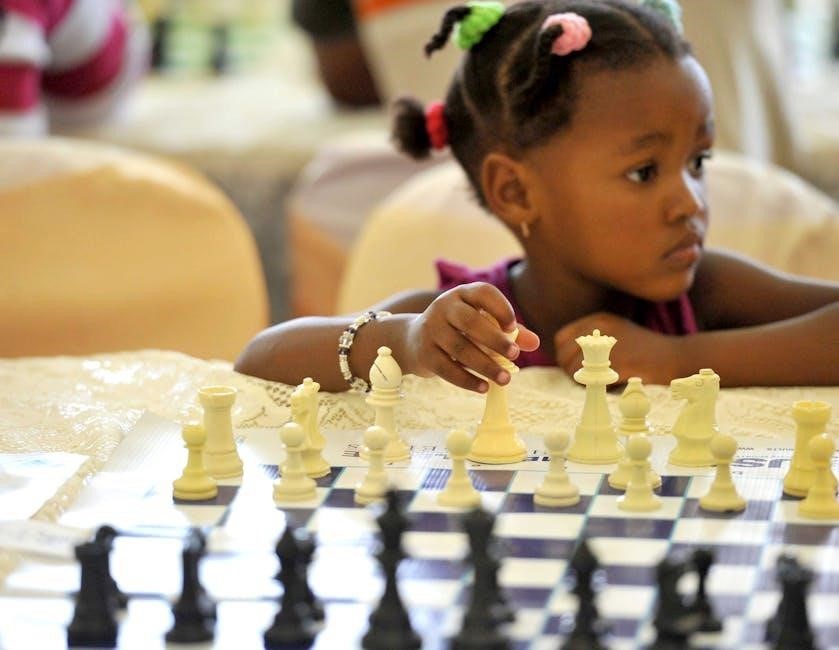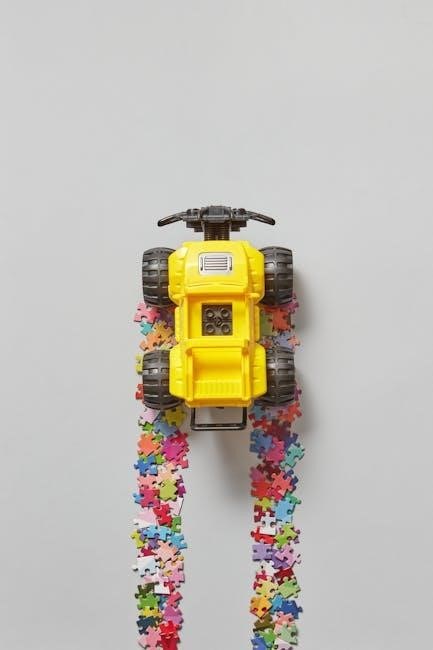This transformative guide by Daniel J․ Siegel and Tina Payne Bryson explores how to nurture your child’s developing brain for emotional and mental balance, offering practical strategies to integrate logic and emotion, fostering resilience and connection․ The Whole-Brain Child provides insights into understanding your child’s brain and helping them thrive through everyday challenges․
Overview of the Book and Its Authors
The Whole-Brain Child is a groundbreaking book by Dr․ Daniel J․ Siegel, a clinical professor of psychiatry, and Tina Payne Bryson, a pediatric and adolescent psychotherapist․ The book offers a comprehensive guide to understanding child development through the lens of neuroscience․ By explaining how the brain functions, Siegel and Bryson provide practical strategies to help parents and caregivers nurture emotional balance and resilience in children․ The authors emphasize the importance of integrating the logical left brain and the emotional right brain to foster healthy growth․ With its accessible and engaging approach, the book has become a trusted resource for parents and professionals alike, offering actionable advice to navigate everyday challenges․
Key Concepts and Objectives
The Whole-Brain Child focuses on helping parents understand their child’s brain development and behavior․ The book introduces the concept of the “upstairs brain” (logical thinking) and the “downstairs brain” (emotional responses), emphasizing the need for integration between these two parts․ A key objective is to provide practical strategies, such as “Connect and Redirect” and “Name It to Tame It,” to help children manage emotions and develop resilience․ By fostering brain integration, parents can transform meltdowns into opportunities for growth․ The authors aim to empower caregivers with tools to nurture emotional and mental balance, ensuring children develop into confident, balanced individuals․ This approach bridges neuroscience with everyday parenting challenges․

Understanding the Brain: Upstairs and Downstairs
The upstairs brain manages logic, decision-making, and self-control, while the downstairs brain handles emotions, reactions, and instincts․ Integration of these parts promotes emotional and mental balance in children․
The Upstairs Brain: Logical Thinking and Decision-Making
The upstairs brain is responsible for logical thinking, decision-making, and self-control․ It helps children think before acting, consider consequences, and manage emotions․ This part of the brain is still developing in children and teens, often leading to impulsive behaviors․ Parents can support its growth by modeling calm, rational responses and encouraging reflective thinking․ Strategies like “Connect and Redirect” help engage the upstairs brain, teaching children to balance emotions with logic․ By fostering integration between the upstairs and downstairs brain, parents can help their child develop better emotional regulation and problem-solving skills, leading to more balanced and thoughtful behavior․
The Downstairs Brain: Emotional Responses and Reactions
The downstairs brain manages emotions, reactions, and basic survival instincts․ It operates quickly, often triggering emotional outbursts before the upstairs brain can intervene․ In children, the downstairs brain is highly active, leading to intense feelings and impulsive reactions․ Parents can help by acknowledging these emotions and teaching children to recognize and label them․ Strategies like “Name It to Tame It” encourage emotional awareness, helping children calm down and regain control․ By understanding the downstairs brain’s role, parents can better support their child’s emotional development and foster a healthier balance between emotional reactions and logical thinking․ This integration is key to raising a whole-brain child․

The Importance of Brain Integration
Brain integration harmonizes the logical left brain and emotional right brain, fostering emotional balance, mental clarity, and resilience․ It helps children regulate emotions and make thoughtful decisions, promoting overall well-being and development․
Why Integration Matters for Emotional and Mental Balance
Integration is crucial as it unites the logical left brain and the emotional right brain, enabling children to manage emotions effectively and make rational decisions; This balance fosters resilience, reducing meltdowns and misbehaviors․ When integrated, the brain functions cohesively, promoting emotional stability and mental clarity․ Integration helps children process feelings, think critically, and respond thoughtfully, rather than react impulsively․ This harmony is essential for healthy development, allowing children to navigate challenges calmly and confidently․ By integrating brain regions, parents can help their children achieve emotional and mental balance, leading to a more regulated and peaceful childhood experience․

Key Strategies for Parenting a Whole-Brain Child
Strategies like Connect and Redirect, Name It to Tame It, and Engage, Don’t Enrage help parents guide children through emotional challenges, fostering calm and understanding․ Whole-brain parenting equips children with tools for emotional regulation and resilience, promoting a balanced and integrated mind; These approaches encourage empathy, logical thinking, and self-control, helping children navigate emotions effectively while strengthening the parent-child connection․ By applying these methods, parents can transform meltdowns into opportunities for growth and understanding, nurturing a whole-brain child who thrives emotionally and mentally․ These strategies are practical, effective, and rooted in neuroscience, making them invaluable for raising well-adjusted children․ They emphasize the importance of integration between the left and right brain, ensuring children develop both logical and emotional intelligence․ Through consistent use of these techniques, parents can help their children achieve greater emotional balance and mental clarity, leading to healthier relationships and a stronger sense of self․ The strategies are designed to be adaptable to various situations, providing parents with a flexible toolkit to address their child’s unique needs․ Ultimately, whole-brain parenting empowers children to manage their emotions, think critically, and develop into resilient, compassionate individuals capable of handling life’s challenges with confidence and grace․
Connect and Redirect: The Power of Emotional Connection
Connect and Redirect is a powerful strategy that begins with emotional connection, validating your child’s feelings through empathy and understanding․ By engaging the right brain, you create a sense of safety, allowing your child to feel acknowledged․ Once connected, you redirect their focus to logical thinking and problem-solving, involving the left brain․ This approach transforms meltdowns into opportunities for growth, teaching children to manage emotions and develop self-regulation skills․ It fosters resilience and strengthens the parent-child bond, helping children navigate challenges with confidence and emotional intelligence, while nurturing both their emotional and logical development for better decision-making and balance․
Name It to Tame It: Teaching Emotional Awareness
Name It to Tame It is a strategy that helps children recognize and manage their emotions by labeling them․ When a child is upset, acknowledging their feelings verbally reduces emotional intensity․ This approach encourages emotional awareness and teaches children to identify their emotions, making them feel understood․ By naming emotions, parents help integrate the right and left brain, fostering emotional regulation․ This method not only calms the child but also equips them with tools to handle future emotional challenges, promoting resilience and self-awareness․ It’s a simple yet powerful way to guide children toward emotional balance and mental clarity, enhancing their ability to navigate life’s ups and downs effectively․
Engage, Don’t Enrage: Strategies for Calming Meltdowns
Engage, Don’t Enrage focuses on connecting with your child during emotional meltdowns to prevent escalation․ By acknowledging their feelings and validating their experience, you help shift their focus from anger or frustration to problem-solving․ This strategy involves active listening and empathy, which calms the right brain, allowing the left brain to engage logically․ Once the emotional storm subsides, guide your child in reflecting on what happened and how to handle similar situations better․ This approach fosters resilience and teaches children to manage emotions effectively, turning challenging moments into opportunities for growth and understanding․ It’s a powerful way to guide your child toward emotional balance and self-regulation․

Practical Applications of Whole-Brain Principles
Apply whole-brain strategies like “Connect and Redirect” and “Name It to Tame It” to help children manage emotions, fostering emotional awareness and resilience in daily life․
Teaching Children to Regulate Their Emotions
Teaching emotional regulation involves helping children recognize, understand, and manage their feelings․ By modeling calm behavior and using strategies like “Name It to Tame It,” parents guide children to identify emotions, reducing meltdowns․ This approach fosters self-awareness and resilience, enabling kids to navigate emotional challenges effectively․ Over time, these practices help integrate the brain, promoting balance and emotional intelligence, which are essential for long-term mental health and well-being․ Such methods ensure children develop the skills needed to handle stress and setbacks constructively, laying a strong foundation for future emotional stability and healthy relationships․ Consistent practice reinforces these skills, making them second nature․
Using the “Remote of the Mind” to Replay Memories
Using the “Remote of the Mind” strategy, parents can help children replay and process memories, especially emotional ones, to foster understanding and integration․ By guiding kids to revisit experiences, both positive and challenging, parents encourage emotional reflection and resilience․ This technique involves discussing the memory, exploring feelings, and creating a coherent narrative․ It helps children make sense of their emotions and develop a stronger sense of self․ Regular use of this method promotes emotional regulation and mental growth, equipping children with tools to handle future challenges effectively․ This practical approach strengthens parent-child connection and supports healthy brain development, ensuring lasting emotional balance․

The Role of the Right and Left Brain in Development
The right brain manages emotions, while the left handles logic․ Balancing both fosters integrated thinking, emotional regulation, and a cohesive sense of self in children․ This balance is essential for healthy development․
Understanding the Balance Between Logic and Emotion
The right brain, emotional and intuitive, often dominates in children, leading to impulsive reactions․ The left brain, logical and analytical, helps regulate these emotions․ When integrated, they foster balanced decision-making and emotional resilience․ This harmony is crucial for children to navigate challenges effectively, reducing meltdowns and promoting mental well-being․ By understanding this balance, parents can guide their child toward healthier emotional and cognitive development․

Thanks to its practical strategies, The Whole-Brain Child empowers parents to foster emotional balance and resilience․ Additional resources like workbooks offer further guidance for nurturing your child’s mind․
Final Thoughts on Raising a Whole-Brain Child
Raising a whole-brain child is a transformative journey that empowers parents to nurture emotional balance, resilience, and connection․ By integrating strategies like “Connect and Redirect” and “Name It to Tame It,” families can turn challenges into opportunities for growth․ The book emphasizes the importance of understanding the brain’s development and leveraging its potential to foster a balanced, thriving child․ With practical tools and compassionate insights, The Whole-Brain Child equips caregivers to guide their children toward emotional regulation and lifelong well-being, making it an indispensable resource for any parent seeking to raise a confident, whole-brain child․
Recommended Workbooks and Further Reading
For deeper exploration, The Whole-Brain Child Workbook by Daniel J․ Siegel and Tina Payne Bryson offers practical exercises to nurture children’s emotional and intellectual growth․ This resource is ideal for parents, educators, and professionals seeking interactive tools to apply whole-brain principles․ Additionally, No-Drama Discipline and The Yes Brain provide complementary strategies for fostering resilience and emotional regulation․ These books, along with online resources and courses, offer a comprehensive approach to raising a whole-brain child, ensuring long-term emotional balance and mental well-being․ They are essential for anyone committed to understanding and supporting a child’s developing mind․

Leave a Reply